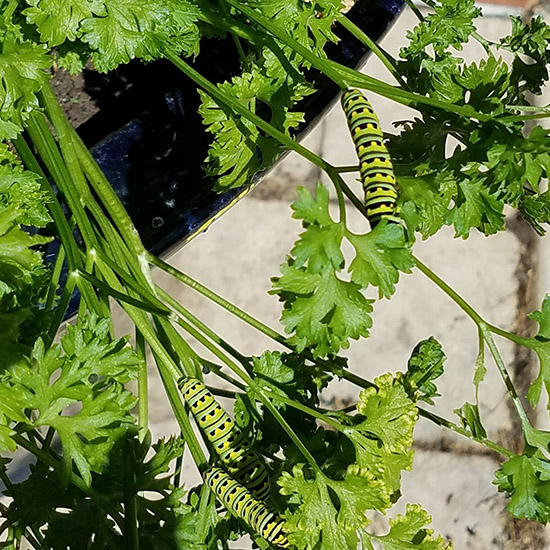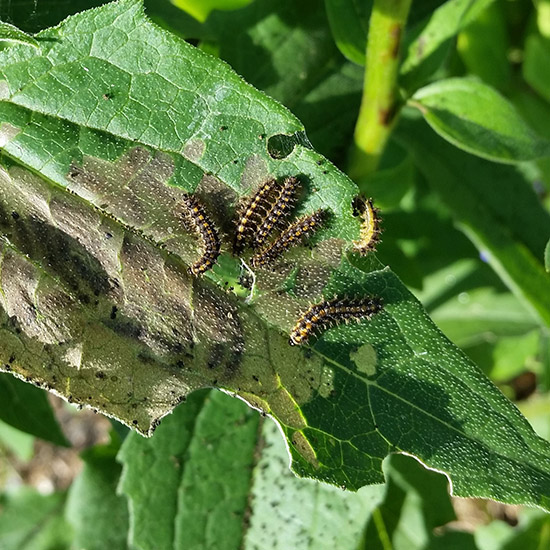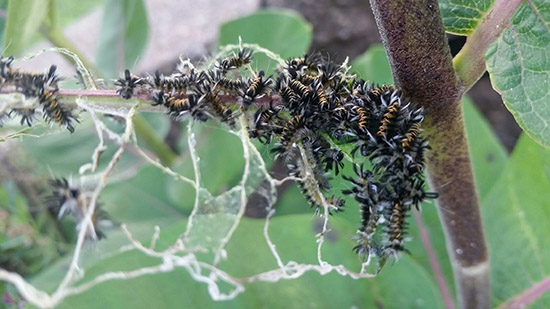Issue 12, July 30, 2018
Butterflies and Caterpillars Abound
Caterpillars are abound this growing season leaving some to wonder, "Are they good or are they bad?" Most gardeners want butterflies and moths sipping nectar from their colorful blooms but are they willing to let the caterpillars take some hefty bites out of the foliage of their plants? Let us hope most gardener are willing, because without the fattening of caterpillars, we would not have our fancy-free winged beauties fluttering in the garden. The latest caterpillar sightings have been black swallowtails (Papilio polyxenes) on parsley, silvery checkerspots (Chlosyne nycteis) on coneflowers and milkweed tussock moth (Euchaetes egle) on milkweed.
Black swallowtail butterflies are large, shiny and black with some iridescent blue and a characteristic orange spot. They lazily move back and forth from flower to flower in gardens and on roadsides. The female lays her eggs on plants in the carrot family including parsley, dill and fennel. The caterpillars hatch and begin feasting on the leaves leaving behind bare stems. They are a light green color with black stripes and yellow dots. When disturbed, a caterpillar may send out a vibrant orange and forked structure, from the top of its head, known as an osmetarium. It is meant to ward off predators by presenting bright warning colors and secreting foul smelling defensive compounds. I like to agitate them with a poke on the head to demonstrate their defense system to the kids. They overwinter as dull brown chrysalises that mimic old fallen leaves.

Black swallowtail caterpillar.
Silvery checkerspot butterflies are half the size of black swallowtails. They are orange, marked with black lines, patches and spots. These butterflies fly low and slow sipping nectar from plants and are mostly seen in forest openings or meadows. The females lay egg clusters on the underside of the leaves of purple coneflower, sunflowers and rudbeckia. The caterpillars are black with brown lines down their sides and covered with black spikes. These caterpillars will eat as a large group, skeletonizing leaves within a few days. They overwinter as caterpillars in the landscape, they do not grow to full size in one season.

Silvery checkerspot caterpillar on coneflower.
Milkweed tussock moths are small with gray wings and yellow stout bodies that are stippled with black dots. As adults, they do not feed but are ready to reproduce. The caterpillars, known as "the other milkweed caterpillar," can defoliate milkweed plants in no time. Their bodies are covered in orange, white and black hair tufts. They are a sight to see. Like monarchs, they have adapted to a poisonous plant so birds will not eat them and, similarly, express the black and orange warning colors. They overwinter as pupae on the ground.

Milkweed tussock moths.
Be sure not to clean up the garden this fall to allow these butterflies and moths to complete their lifecycle and further enchant the gardener. (Kelly Allsup)
Author:
Kelly Allsup